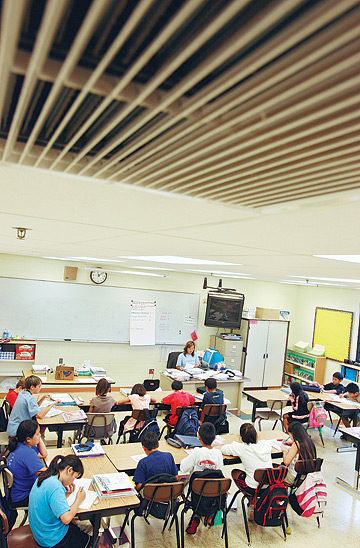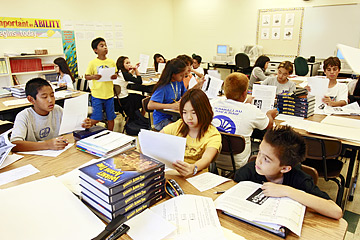
GEORGE F. LEE / GLEE@STARBULLETIN.COM
An air conditioning grate allows cool air into a classroom at Mililani Middle School on Friday. Isle schools are seeking ways to keep kids cooler and fresh for learning.
|
|
Schools will try to beat isle heat
High temperatures force creative ideas including new designs for Hawaii schools
The new school calendar, which starts July 27, will put Hawaii's public school students in class for the hottest months of the year, with little relief in sight.
"There's no getting around the fact that it's very hot," said Stephen Schatz, principal of Pohakea Elementary School in Ewa Beach, which ranks third on the Department of Education's priority list for air conditioning. "People become tired when it's 90 degrees and on up."
"I don't know what the state budget looks like, but I can't think of a better way to spend money than to air condition schools, especially on the Leeward Coast and hot areas of the neighbor islands."
Just 20 public schools, less than a tenth of the statewide total, are fully air-conditioned. When new schools are built, they come with air conditioning. So do new classroom buildings put up on old campuses. But retrofitting entire schools for air conditioning is expensive, roughly $3.5 million to $4 million for a small school.
The Department of Education usually gets enough money to air-condition just one old school every year and a half to two years, according to Sanford Beppu, capital improvement projects planner in the Facilities Development Branch. Things should move a little faster this year because legislators allotted $10 million for noise and heat abatement projects at schools, up from the usual $2 million annually.
King Kamehameha III, on busy Front Street in Lahaina, made the switch to air conditioning a few years ago, and Kihei Elementary is in the process now. Next on the list are Lokelani Intermediate on Maui, Pohakea Elementary in Ewa Beach and Hickam Elementary.
"It's definitely been a good thing for our kids and our teachers," said King Kamehameha's principal, Lindsay Ball. "The kids are fresh, they're on task. It's hard to stay focused when you're drained and you're tired. After lunch it was just so hot it was hard to keep a child attentive."
The traditional school calendar, starting in the fall, has gradually given way to earlier starts and shorter, more frequent breaks. Beginning this year, all public schools will open by the end of July, on a single calendar designed to make school operations more efficient and to boost learning.
August and September tie for the hottest months of the year on every island, with the average maximum daily temperature in Honolulu reaching 89 degrees, according to Kevin Kodama, hydrologist with the National Weather Service. Humidity also rises then because of warmer ocean surfaces, making it feel more uncomfortable.
But air conditioning is not a perfect solution. Not only does it cost a lot up front, it permanently boosts electric bills and takes a toll on the environment. With electricity costs soaring because of the recent spike in the price of oil, the Department of Education is also trying other ways to make schools more comfortable, through better building design and orientation, solar vents and insulation.

COURTESY FERRARO CHOI AND ASSOCIATES LTD.
Waipahu Intermediate's cafeteria has a cavity roof to siphon out warm air for energy efficiency and comfort.
|
|
"Most of our new buildings, whether they're temporary or permanent, are much better environments," said Nick Nichols, a planner in the Facilities Development Branch. "But we're still lacking the amount of money to do massive renovations or retrofits. That's one of the frustrations we have."
When kids return to Waipahu Intermediate School on July 28, they'll step into the first state facility with LEED Green Building Certification: a new cafeteria with high ceilings and exposed wooden beams. The dramatic design is supposed to keep students cool naturally, according to Mark Ayer, project designer for Ferraro Choi And Associates Ltd.
Windows and jalousies on the lower level bring in tradewinds and cooler air that escapes through the roof as it heats up. The cafeteria relies on diffused natural daylight and features a cavity roof that siphons warm air upward and expels it outside.
"It is a beautiful cafeteria," said Principal Randell Dunn, who got to sample it with students as the school year ended. "It's much cooler in the dining area than in the old cafeteria. It's not like air conditioning, but it is much cooler because of the way it is designed and the way the wind blows through."
The Honolulu Chapter of the American Institute of Architects has also teamed up with the University of Hawaii School of Architecture to develop and test new designs for portable classrooms, with help from Group 70 International Inc. and Lincolne Scott Inc. They hope to hand over the new plans to the Department of Education in the next month or two.
Three years ago, architecture graduate students monitored conditions in the portables at Waianae High School under a grant from the U.S. Department of Energy and the Rebuild Hawaii Consortium. They found that internal temperatures in some of the older ones reached as high as 90 degrees even in October.
"None of us wanted to stop at that point," said Stephen Meder, director of the Center for Smart Building and Community Design at the University of Hawaii. "We wanted to offer a positive recommendation. Everyone's interested in making the portable classrooms more comfortable."
Group members volunteered their time to develop designs that will reduce energy demands while increasing comfort.
"They will be very energy conserving, with more daylight and less reliance on electric light," Meder said. "We are looking at natural ventilation and good building design and orientation to mitigate thermal gains so that we don't have to air condition."
The Department of Education is also just starting to use new "High Performance Hawaii School Guidelines" adopted in collaboration with Architectural Energy Corp. and the Department of Business and Economic Development. They provide a roadmap for designing new school buildings and major renovations to be efficient and comfortable. The guidelines use daylight, roof insulation, overhangs, and mixed-mode ventilation that allows air conditioning to be shut off when not needed.
"There's a lot of progress being made in many different areas all along this front," said Duane Kashiwai, public works manager for the Department of Education. "The public might not see all of it. We're nowhere near where we were. We're not just static."

GEORGE F. LEE / GLEE@STARBULLETIN.COM
A sixth grade class classroom is comfortable and cool due air conditioning at Mililani Middle School on Friday.
HOT SCHOOLS
The Department of Education ranks these schools as top priorities for air conditioning.
1. Kihei Elementary (project under way)
2. Lokelani Intermediate
3. Pohakea Elementary
4. Hickam Elementary
5. Ewa Beach Elementary
6. Ilima Intermediate
7. Campbell High School
8. Kamaile Elementary
9. Kaimiloa Elementary
10. Nimitz Elementary
11. Mokulele Elementary
12. Pearl Harbor Kai Elementary
Two new schools that are under construction will both be air-conditioned:
» Keoneula Elementary in Ewa Beach (opens in January 2007)
» Maui Lani on Maui (opens in July 2007)
Source: Hawaii Department of Education
|
|

